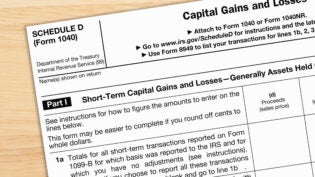6 Steps to Take This Fall to Reduce Your Tax Bill in 2017
By: 1800Accountant

The weather is gradually cooling down, and the leaves are starting to change color if you’re a northerner. Football action has kicked off. Can you finally feel fall in the air?
While we’re still a few months out from the calendar turning to 2017, tax season will be here before you can say “IRS.”
With some expected changes coming for tax filers in the spring, it’s imperative to be prepared and know what you can do now to save. Take the following steps now.
1. Confirm Your Tax Filing Status.
If you have had any major changes in your life this year, or there’s a chance you could still experience one before the big New Year’s Eve celebration in Times Square, there is a possibility your filing status could change with the IRS in the new year.
For instance, you may now have the option of filing a joint tax return with your new spouse if you tied the knot and got married this year. In the past, you’ve likely filed an individual income tax return.
If your situation as a parent changed this year, there’s a chance you may be able to take on the head-of-household filing status instead of simply being an individual filer. Also, if you and your spouse had a child this year, don’t forget to claim your new son or daughter as a dependent.
So, why is it important to know if you can change your filing status? There are lots of potential benefits you can take advantage of with a new IRS filing status that you likely weren’t eligible for in the past. These benefits, which include both tax deductions and tax credits, can significantly help reduce your tax bill.
2. Get your tax documents in order.
After determining your IRS filing status, you should work on organizing all of your tax-related documents and records. Getting this paperwork in order now can make finding relevant information so much easier when the 2017 tax season arrives. Others will be scrambling, but you’ll be sitting back in your recliner and totally prepared for your duties as a tax filer.
Consider making up several folders in which you can categorize your tax and financial records. For example, have 3 folders labeled as “tax returns,” “business receipts,” and “bank statements.” It can also be helpful to take pictures of your receipts and scan other records onto your computer.
Just make sure your Wi-Fi network is secure and you save your files on a device that has a password.
Having receipts on file, in order, and easily accessible is particularly important to your ability to claim various tax breaks, such as deducting meals and entertainment, vehicle expenses, or charitable contributions. The IRS often wants proof of your write-offs, so you may need to include receipts and other acknowledgements when you submit your return.
3. Make simple calculations about your tax bill and potential refund.
Even if you’re not a math professor, there are some easy calculations you can do to predict what your potential tax bill will be and what your refund check may look like if you’re expecting to get money back.
Take a look at the amount of income you have earned in 2016, along with how much more you expect to earn.
Then map out the tax deductions, credits, and other tax breaks you plan to claim that will lower your tax liability If you have an income amount in mind, and you can subtract the amount of taxable income you’ll be able to reduce through tax breaks, this should give you the amount you’ll have to pay taxes on—at least within a ballpark range.
Confirm the income tax bracket you will fall into—and whether this rate may change compared to previous years.
If you have taken home 1099 contractor or business income this year, don’t forget to include this information as well.
Upon coming up with these figures, you should have a decent idea about how much your tax bill will be and the amount of your potential refund.
4. Set aside some extra cash for yourself.
Even though you don’t expect a big tax bill from Uncle Sam in 2017, or you are counting on a large refund being directly deposited into your bank account, it’s still a good idea to set aside some extra money from your income to have for tax-paying purposes. You certainly do not want to be strapped for cash when you get hit with a late-payment or late-filing penalty. Consider taking just 4 or 5 percent out of your paychecks you get every other Friday to have on hand.
Plus, the IRS recently announced that tax refunds will be delayed for many taxpayers in 2017. So, this is simply another reason to have some extra cash in savings in case you’re one of the lucky ones who has to wait for your tax refund check longer than usual.
5. Find out if you’re eligible for new tax breaks.
Because of constantly changing tax laws, you should take the time to determine if you qualify for any new deductions for which you have never been eligible. It’s also worth making sure that write-offs or credits you claimed last year have not changed in terms of their value or income limitations required to claim them.
For example, if you and your spouse had a baby this year, you may be eligible to claim the Child Tax Credit. If you started a drone photography company in your city, you’ll likely qualify for a number of new business deductions that you could never take before to help reduce your taxes. No matter what your situation is, it’s wise to notate your tax breaks now rather than trying to find them out at the last minute next spring.
6. Don’t forget about the new filing deadlines for some businesses.
Within the last year, Congress announced its decision to change some of the longstanding tax deadlines for the annual filings of certain business entities. These tax deadline changes were part of the Surface Transportation and Veterans Health Care Choice Improvement Act of 2015.
Starting in 2017, business partnership tax returns—Form 1065—will now be due on March 15 each year. In the past, these tax returns have been due on April 15. This means you’ll need to get your return prepared and submitted one month earlier than prior years, so make appropriate plans to prepare earlier for the new deadline.
It’s also worth mentioning that if you operate a partnership that is not based on a calendar year, your partnership tax return will be due by the 15th day of the third month after the close of your specific tax year.
Also beginning in 2017, tax returns for C corporations—Form 1120—will be due April 15. This date was pushed back from the previous deadline of March 15, giving C corp owners a little extra time to have their returns prepared and sent off.
For C corporations on non-calendar year schedules, your C corp tax return will now be due on the 15th day of the fourth month after a tax year comes to a close. C corps with tax years that close on June 30 will still have a tax return deadline of September 15 – until the year 2025. As for tax years beginning after 2025, the deadline for certain C corp tax returns will be moved up to October 15, giving small business owners an additional month to file their business taxes.












